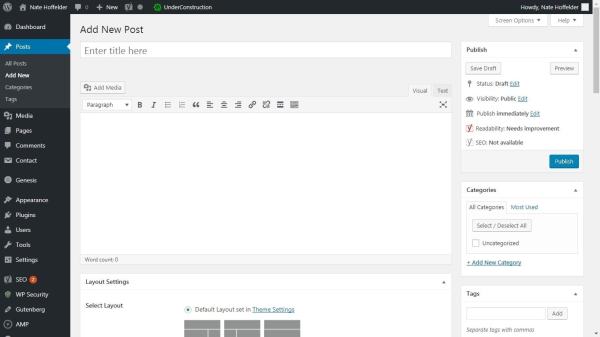WordPress is about to go through an epochal change, and no one knows whether it’s going to be a huge flop or a raging success.
When Coca-Cola introduced New Coke in April 1985, it thought it a product that everyone would love. Focus groups liked it, randomly sampled consumers asked for seconds, and there was a huge marketing campaign set up to push the new and improved Coke flavor.
And then New Coke bombed. Consumers didn’t really want the taste of Coke to change. They liked what they had, so much so that Coca-Cola had to rush the original Coke recipe back into production less than 3 months after lunching New Coke.
WordPress is coming to a similar crossroad where everything you know about WordPress is going to change. That change is called Gutenberg, and it is coming with the 5.0 WordPress release.
O O O
What is Gutenberg, you ask?
Not to be melodramatic, but it is the end of the world. Named for the German printer, Gutenberg is currently still a plugin in beta testing, but in the long run it will be a core WordPress component.
As Morton Rand-Hendricksen concisely explained, Gutenberg changes the very fundamental assumptions about how you use WordPress.
Gutenberg is a comprehensive reimagination of content creation and editing both in terms of user interface design and structural approach. Rather than treating an article as a blob of content where selected segments (words, sentences, paragraphs, blockquotes, images, captions etc) are treated as units of a larger whole, each segment is its own “block” which can be assigned a type, moved around, and handled with relative independence.
An oversimplified explanation would be to say when you create something under the Gutenberg paradigm, rather than adding content to a “blob” you add an a “block” describing the content type and place content within it.
Gutenberg is going to change everything from how you create a post to how designers build pages on a WordPress site.
Or at least that is the plan. Right now the Gutenberg plugin is limited to just providing an alternative to the content editing menu.
The current editor looks like this:
The Gutenberg content editor interface, on the other hand, looks like it was copied from Medium.
It has so little detail that it goes beyond minimalist to become what is almost a zeroist interface.
That is a huge change in the interface, so much so that it has lead many users to trash the plugin with one-star reviews.
I too was shocked by the differences, but then I started playing with the demo post and I soon came to appreciate the changes. That demo post was much prettier than most of my posts. It had text on top of images, an automatically generated TOC, edge-to-edge images, and more.
I don’t use most of those features in my posts because they are very hard to create in the existing content editor.
The new editor is supposed to make it easy for everyone to create “rich media” posts. If it works out then blog posts on WordPress sites are going to start getting a lot prettier.
But will it work out? Now that is another question.
O O O
The demo post looked gorgeous but for the life of me I could not figure out how to create an edge-to-edge image in the new Gutenberg editor or how to add the text on top of an image.
Were these features not implemented yet or are they hidden so well that I can’t find them?
I honestly cannot tell.
What I do know is that Gutenberg currently promises features that it does not deliver. It frustrated an experienced and enthusiastic geek, so just imagine how the average non-techie user is going to feel when confronted by the new interface.
This is truly WordPress’s New Coke moment.
Will users reject Gutenberg en masse, or adopt it?
My gut feeling is that if users share my frustrations with Gutenberg, they will demand the return of the old interface.
But the official release is months and months away, so it is entirely possible that a UX (user experience) expert will force the Gutenberg developers to make Gutenberg easier to use before it is inflicted upon an unsuspecting public.
Have you tried the Gutenberg plugin yet?








Agreed. There are a lot of users who don’t want to learn how to be their own IT or Web Designer. Transitioning to Gutenberg will require documentation written for the least experienced user, something WordPress is horrible at. If you know PHP, there’s everything you want. If you just want to set up a simple website, it becomes exponentially more difficult.
How would you like to track this? I think Gutenberg will be a huge success. I’ll bet you a case of Coke if you win, a case of Dr Pepper if I win. ?
I was forced to update my WordPress.org theme because my old theme was abandoned a few years ago and I was hacked. I’ve been going through quite a learning curve. Your is very timely. Thank you.
Glad I could help, Lynn!
Absolute non-techie here. Gutenberg showed up on an unpopulated site of mine, so I played with it a bit.
What’s all the tumult about? Gutenberg is not as much fun as the old iWeb, which I adored but which Apple evidently didn’t, but it’s rather fun in its own way. Looks to me like they’ve widgetized the composition pane. Just that. It’s something to play with and enjoy, like a mansion full of hidden passageways.
Does WordPress often leave me dazed and confused? Always. But not this. This is just a different way to make up a page. I’ve done that with every kind of process going back to waxed paper and non-repro graph paper “mechanicals.” LOL–in college, we got to set type, actual lead type, tiny little letters, one at a time. Backwards, as I recall.
All that SEO and ping backs and the way it screws up large images and other tech underbrush on the back side, yes, that’s daunting and I wish my fairy godmother would show up with a tireless tech-wand. But Gutenberg? It’s just a way to make up a page. I look forward to finding all its secret doors.